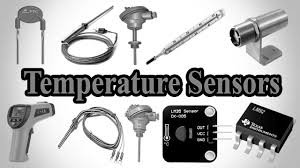What are the various types of temperature sensors and how do they differ?

Here’s a detailed explanation of the various types of temperature sensors and how they differ based on their working principles, applications, advantages, and limitations:
Overview of Temperature Sensors
Temperature sensors are devices used to measure heat energy or detect temperature changes. They convert temperature into a readable signal, often electrical. Different types of temperature sensors are suited to different environments and levels of precision.
Types of Temperature Sensors
1. Thermocouples
-
Working Principle: Thermocouples generate a voltage when there is a temperature difference between two dissimilar metals joined at one end (Seebeck effect).
-
Common Types: Type J, K, T, E, N, R, S
-
Temperature Range: -200°C to +1800°C (varies by type)
-
Accuracy: Moderate
-
Advantages:
-
Wide temperature range
-
Fast response time
-
Inexpensive and durable
-
-
Limitations:
-
Non-linear output
-
Requires reference junction compensation
-
-
Applications: Furnaces, engines, kilns, scientific labs
2. Resistance Temperature Detectors (RTDs)
-
Working Principle: RTDs change resistance with temperature; typically made of pure platinum (e.g., PT100).
-
Temperature Range: -200°C to +600°C
-
Accuracy: High
-
Advantages:
-
Very accurate and stable over time
-
Repeatable readings
-
-
Limitations:
-
More expensive than thermocouples
-
Slower response time
-
Sensitive to vibration
-
-
Applications: Industrial process control, HVAC, medical devices
3. Thermistors
-
Working Principle: Thermistors are temperature-sensitive resistors, usually made from ceramic materials. They come in NTC (Negative Temperature Coefficient) and PTC (Positive Temperature Coefficient) types.
-
Temperature Range: -50°C to +150°C (some up to 250°C)
-
Accuracy: Very high in limited ranges
-
Advantages:
-
High sensitivity
-
Cost-effective
-
-
Limitations:
-
Narrow temperature range
-
Non-linear response
-
-
Applications: Consumer electronics, automotive systems, battery management
4. Infrared (IR) Temperature Sensors
-
Working Principle: Detect infrared radiation emitted by an object and convert it into a temperature reading.
-
Temperature Range: -70°C to +1000°C (varies)
-
Accuracy: Moderate to high depending on calibration
-
Advantages:
-
Non-contact measurement
-
Ideal for moving or hot objects
-
-
Limitations:
-
Sensitive to emissivity and environmental conditions
-
More expensive
-
-
Applications: Food safety, medical thermometers, industrial monitoring
5. Semiconductor-Based Sensors (IC Sensors)
-
Working Principle: Use built-in electronic circuits to measure temperature using voltage changes in diodes or transistors.
-
Temperature Range: -55°C to +150°C
-
Accuracy: Moderate
-
Advantages:
-
Small size, easy to integrate into circuits
-
Digital output options (e.g., I²C, SPI)
-
-
Limitations:
-
Limited temperature range
-
Not suitable for extreme environments
-
-
Applications: Embedded systems, consumer electronics, smart devices
Comparison Table
| Sensor Type | Accuracy | Temperature Range | Cost | Response Time | Contact/Non-contact |
|---|---|---|---|---|---|
| Thermocouple | Moderate | Very Wide (-200°C–1800°C) | Low | Fast | Contact |
| RTD | High | -200°C to 600°C | Medium-High | Moderate | Contact |
| Thermistor | Very High | -50°C to 150°C | Low | Fast | Contact |
| IR Sensor | Moderate-High | -70°C to 1000°C | High | Instant | Non-contact |
| IC Sensor | Moderate | -55°C to 150°C | Low | Fast | Contact |
Conclusion
Each type of temperature sensor has its own strengths and is best suited for specific applications. The choice depends on factors like temperature range, accuracy, environment, response time, and budget.
🎓 Discover one of the best Pharmaceutical Production courses available — click below to explore the course that’s shaping future Production skills.

